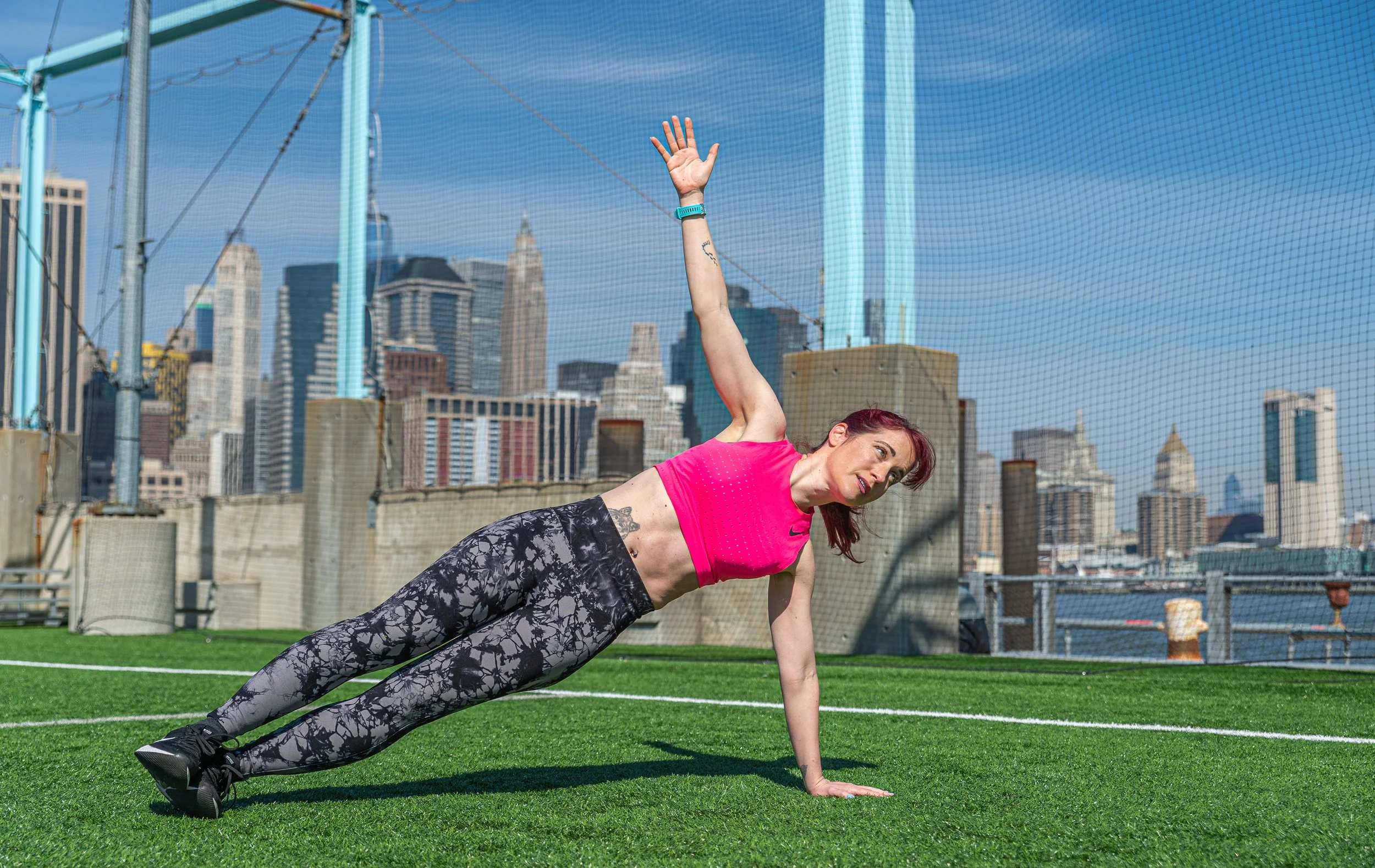3 Core Exercises to Torch Your Abs
By Marnie Kunz, NASM-certified trainer
These core exercises offer some of the most effective ways to strengthen your abs. Whether you’re aiming to see more definition in your abs or become a stronger athlete and improve your performance, these core exercises will help. And you can adapt the core workouts to your fitness level, making them more or less difficult depending on where you’re at with your fitness. Keep in mind that if you want to lose weight, in addition to strengthening your abs, you will need to follow a fitness plan for a full-body effort to lose body fat and get lean.
Benefits of Core Exercises
Strengthening your core muscles will help define your midsection and, when combined with a full-body fitness program, can help you get defined abs. But these abs exercises will also do more than tone your abs and offer definition. A strong core offers many benefits — helping stabilize your body for daily movements and exercises and improving your sports performance. Strengthening your abs can also prevent running and sports injuries as well and enhance posture.
Here are some of the main benefits of strengthening your core muscles:
Better balance and stability. A strong core helps your balance and stability, which makes you less likely to fall or get injured.
Improved athletic performance. Strong core muscles will improve your running and sports performances and reduce your risk of sports injuries.
Reduces lower back pain. According to Harvard Health, core workouts are often prescribed to help reduce low back pain, which affects 4 out of 5 Americans at some point in their lives.
Better posture. A strong core helps improve your posture, which takes pressure off your spine, preventing pain and injuries in your neck and back. (See our article with workplace tips for better posture for more help combatting too much sitting and posture problems).
Anatomy of Abs
When people talk about their “abs” they usually mean the rectus abdominis, which give people the visible 6-pack abs. The rectus abdominis also flexes the spine, allowing you to move your body forward while doing things like sitting up. The abs are comprised of three main muscles, including the transverse abdominis, which is a layer of abdominal muscle deep in the abdomen. This muscle helps stabilize the lumbopelvic hip complex, providing a natural built-in girdle that draws in the core. The obliques are muscles that run along the sides of your core and help with side movements such as side crunches as well as stabilize the spine.
The core exercises here will help strengthen each muscle in your abs so you have a stronger, more defined core and improved posture, balance, performance, and stability.
3 Exercises to Strengthen Your Core
These are the top three core exercises I recommend for training clients to strengthen the core muscles without putting too much pressure on the spine:
Flutter kicks
Planks
Side planks
Flutter Kicks
Flutter kicks are one of my favorite core exercises because they involve ongoing motion so you are not holding one pose the whole time. Flutter kicks work your lower core muscles, including the rectus abdominis and the hip flexors.
To do flutter kicks, lie on your workout mat facing up, with your arms by your sides. Place your hands under your glutes, engage your core muscles, and alternate lifting one leg and then the other in a fluttering, kicking motion. When you lift each leg bring your feet about 6 inches above the floor. If you’re a beginner you can let each foot tap the floor when it comes back down. For advanced flutter kicks, do not let either foot touch the floor and only let the lowered foot go to an inch or two above the ground.
Tips: Keep your chin tucked as if you are lightly holding an egg under your chin throughout the movement. Do not strain your neck. Remember to breathe throughout the exercise.
Variations: Once you master the flutter kicks, you can add light ankle weights if you want to add even more intensity to the exercise.
Planks
Planks are a staple of most core workout programs for good reason — they strengthen all of the ab muscles — including your rectus abdominis, obliques, and transverse abdominis. Planks are very adaptable to different fitness levels, with variations ranging from modified planks to planks with leg and even arm lifts. Planks also have a lower risk of injury than some core exercises such as sit-ups and crunches, which put more pressure on the spine and neck.
To do a forearm plank, begin from a lying position on your stomach. Push up into a bent arm position, with your weight resting on your forearms and toes and your shoulders above your elbows. Maintain a neutral neck and spine and keep your body in a straight line.
Tips: Do not let your hips come up or sag during the plank. Imagine a straight line from your head down to your toes and try to maintain this posture. If it is too difficult to do the forearm plank, begin with modified planks.
Modifications: Beginners can start with modified planks. To do a modified forearm plank, begin from the lying down position and push up onto your forearms and knees. Keep your knees slightly bent and rest your weight on your forearms and knees. Maintain a tight core and keep a straight line from your head down to your knees.
Variations: For advanced planks, you can add more time to your planks or try lifting one leg at a time slowly as you hold your plank. This adds more glute and hip strengthening to the exercise as well as challenges balance and core stability. Another option is straight arm planks, where you place your hands below your shoulders instead of resting on your forearms. Straight arm planks add more shoulder and arm strengthening elements to the exercise. For an advanced variation, try straight arm planks where you lift one arm and the opposite leg at the same time. Alternate and lift the other limbs. You can also add more of a challenge to any planks by increasing your plank time.
Side Planks
Side planks are great to strengthen the oblique muscles which run along the side of your core. To do a side plank, begin by lying on your side on your workout mat, stacking your feet on top of each other with your toes and hips facing forward. Keep your neck in a neutral position. Lift up onto your side forearm closest to the ground, and tighten your ab muscles.
Tips: Keep your head and neck in a neutral position for the side planks, with your face, toes, and hips facing forward. Think of a straight diagonal line running from your head down to your toes.
Modifications: You can do modified side planks by resting your lower leg on the ground with your knees bent.
Variations: You can also do side planks from a straight arm position, resting your weight in the hand of the straight arm and your feet. For an extra challenge, try raising your top leg slowly and then lowering it back to rest on top of your bottom leg. Repeat on the other side. You can also add more time to your side planks to increase the challenge.
How Often To Do Core Exercises
In contrast with what many people think, you do not need to do hours of ab workouts to strengthen your core muscles or get flat abs. Doing 2 to 3 ab workouts a week for 10 minutes builds a solid fitness base. I recommend doing core exercises at the end of your strength workouts, after any weightlifting activities.
Sample Core Workout
Here is a sample core workout to get you started:
Mountain climbers: 1 minute
Planks: 30 seconds
Flutter kicks: 30 seconds
Side planks: 20 seconds on each side
Repeat to do 3 sets of each exercise with 30 seconds of rest between each circuit. You can add more time to the exercises as you build strength.
Have you tried any of these core exercises? Which variations do you prefer? Comment below and tag @Runstreet on Instagram to share your workouts and get cheered on.
Related Posts: How to Do Mountain Climbers, Benefits of Burpees for Runners, 3 Best Glute Exercises to Get Results
Marnie Kunz is a NASM-certified Brooklyn trainer, USATF, and RRCA-certified running coach, and the creator of Body by Runstreet and Runstreet Art Runs, which bring together communities through running and street art. She is a Brooklyn resident, trainer, Akita mom, and writer. She enjoys running coaching, traveling, art, and eating messily.




